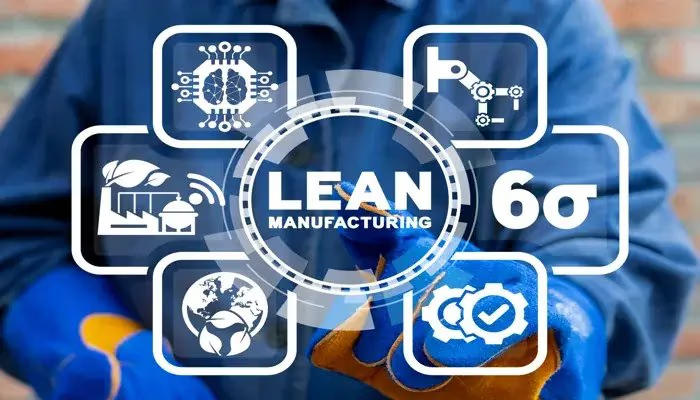Summary: In today’s highly competitive business environment, companies must focus on reducing costs and improving profits to remain competitive. One of the most effective approaches is the 3P (Production Preparation Process) Lean methodology. This method helps businesses streamline their operations, eliminate waste, and optimize production efficiency by focusing on product or process design from the outset. The 3P approach enables early evaluation of processes, helping to identify inefficiencies and drive optimization efforts.
Understanding 3P (Lean)
3P (Lean) provides a structured framework for developing product or process designs that are less complex and more efficient. This methodology encourages companies to test potential designs, aiming to eliminate waste by focusing on both product and process optimization. A dedicated 3P team collaborates to assess the process from start to finish, ensuring that every aspect is aligned with the company’s efficiency and productivity goals.
What is 3P (Lean)?
The 3P methodology, rooted in Lean manufacturing principles, focuses on optimizing production efficiency while minimizing waste and reducing costs. The goal is to improve product and process design early in the production cycle to ensure both quality and efficiency. By engaging cross-functional teams and utilizing various Lean tools, 3P fosters collaboration and innovation, leading to substantial improvements in production processes. 3P often complements other Lean methods, such as Kaizen, to ensure comprehensive improvement. By continuously evaluating product or process designs, businesses can ensure more effective and structured processes, resulting in streamlined operations, reduced costs, and higher profits.
The Production Preparation Process (3P)
At its core, 3P focuses on designing effective production processes that eliminate waste and maximize value. This process involves analyzing and optimizing each step, from evaluating feasibility to creating and testing prototypes. Through a thorough review and feedback process, companies develop superior designs, leading to increased productivity and cost savings.
Lean Methods Supporting 3P
Understanding the broader Lean context is essential to grasp the effectiveness of 3P. Lean manufacturing aims to create customer value while reducing waste and maximizing efficiency. It integrates principles and tools like Kaizen, Six Sigma, and 5S, which complement 3P efforts. Together, these methods enable businesses to continuously improve their production processes and optimize resource usage.
Want to elevate your 3P Lean approach?
Explore how Manufacturing Operations Management software can simplify and improve your process management.
Key Steps in the 3P Lean Process
The 3P Lean process involves several critical steps to ensure a comprehensive approach to production preparation:
- Planning a 3P Event: This involves organizing a collaborative event where relevant stakeholders and experts can analyze current processes and brainstorm improvements.
- Assembling the Team: Cross-functional teams with diverse skills drive innovation and problem-solving.
- Evaluating the Current Process: Lean tools like value stream mapping are used to identify waste and inefficiencies.
- Designing and Testing Prototypes: Multiple process prototypes are developed and tested to find the most effective design.
- Incorporating Feedback: Feedback from stakeholders is used to refine the process, ensuring continuous improvement.
- Implementing the Finalized Design: Once optimized, the process is implemented, and its performance is monitored closely.
Tools and Techniques Used in 3P Lean Methodology
A range of Lean tools and techniques support successful 3P implementation. These include:
- Value Stream Mapping: Visualizes the production process to identify waste.
- Process Flow Analysis: Examines the flow of materials and information.
- Failure Mode and Effects Analysis (FMEA): Assesses potential failure modes and their impacts.
- Rapid Prototyping: Allows for quick, cost-effective testing of process prototypes.
- Design for Manufacturability (DFM): Ensures designs are optimized for manufacturing.
- Statistical Process Control (SPC): Monitors production quality through statistical methods.
- Kanban Systems: Visual tools for managing inventory and production control.
Successful 3P Implementation Examples
Organizations across industries have benefited from 3P. A leading automotive manufacturer redesigned their assembly line, reducing production time by 30% and improving productivity. Similarly, a pharmaceutical company used 3P to enhance packaging processes, cutting costs and increasing efficiency. These examples demonstrate the transformative impact of the 3P Lean methodology.
Implementing 3P in Practice
To successfully implement 3P, careful planning and execution of a well-structured 3P event are crucial. This event should bring together stakeholders, experts, and team members to collaborate on process design. The right resources, materials, and tools must be readily available, fostering a creative and collaborative environment. Leveraging collective expertise allows organizations to generate innovative solutions for process improvement.
1. Selecting the Right Team for a 3P Project
The success of a 3P initiative largely depends on having the right team in place. A diverse, cross-functional team composed of individuals from departments like manufacturing, engineering, quality assurance, and supply chain ensures a holistic approach to process design. Fostering effective communication and collaboration within this team allows the 3P methodology to achieve its full potential.
2. Evaluating the Current Process
Before entering the design phase, a thorough evaluation of the current production process is essential. This evaluation identifies areas of waste, inefficiency, and bottlenecks using Lean tools such as value stream mapping and process flow analysis. The insights gained during this assessment form the foundation for designing and optimizing future processes.
3. Designing and Testing Process Prototypes
The design phase involves creating alternative process prototypes that address the waste and inefficiencies identified earlier. Rapid prototyping allows for the quick development and testing of multiple designs, enabling businesses to evaluate each prototype’s feasibility and effectiveness. This iterative approach ensures continuous improvement of the final process design.
4. Incorporating Feedback and Making Improvements
The 3P process relies on incorporating feedback from all stakeholders throughout the design phase. By continuously gathering input and making adjustments, organizations can refine their process designs and ensure that they meet the goals of efficiency, quality, and cost reduction. The iterative nature of 3P fosters a culture of continuous improvement, essential to achieving long-term operational excellence.
3P and Continuous Improvement
Continuous improvement is a core principle of Lean manufacturing, and 3P is a vital component of this approach. By encouraging employees to identify and eliminate waste, organizations can establish a culture of continuous improvement. The iterative cycles within the 3P process ensure that improvements are ongoing, leading to enhanced innovation and production efficiency.
Integrating 3P with Other Lean Methodologies
While 3P is a powerful tool on its own, it is even more effective when combined with other Lean methodologies. For instance, Kaizen events can help engage employees in problem-solving and encourage continuous improvement. Additionally, Six Sigma principles can be applied alongside 3P to ensure consistent quality and process reliability. Together, these methods form a robust framework for optimizing production processes.
Combining 3P with Six Sigma
Integrating Six Sigma with 3P can yield significant benefits for process improvement. Six Sigma provides a data-driven approach that minimizes process variation and defects. When used in conjunction with 3P, organizations can not only achieve efficiency but also ensure that their processes are reliable and consistently deliver high-quality products. This synergy leads to operational excellence and improved customer satisfaction.
Cost Reduction and Profit Boost Through 3P
Specific strategies for cost reduction through 3P include:
- Reducing Raw Material Waste: Optimizing material use minimizes waste and rework.
- Labor Efficiency: Streamlining processes can reduce labor requirements and improve workflow.
- Optimizing Equipment Use: 3P helps avoid unnecessary capital expenditures by improving equipment utilization.
- Inventory Management: Lean inventory practices such as Just-In-Time (JIT) reduce holding costs and prevent obsolescence.
Maximizing Efficiency and Productivity
Efficiency and productivity improvements are key outcomes of 3P. By eliminating non-value-added activities and streamlining workflows, organizations can increase their output per unit of time and resources. Optimized process designs also lead to better resource allocation and reduced bottlenecks, further enhancing productivity.
Overcoming Challenges in 3P Implementation
Organizations may face challenges such as resistance to change, limited resources, and lack of collaboration when implementing 3P. To overcome these obstacles, companies should:
- Manage Change Effectively: Clear communication, employee training, and involvement in the process help mitigate resistance.
- Encourage Cross-Functional Collaboration: Teams from different departments bring diverse perspectives, enabling more comprehensive solutions.
- Set Realistic Goals: Establishing achievable objectives ensures alignment with organizational capabilities and fosters long-term success.
Tips for Ensuring Successful 3P Implementation
To ensure successful implementation of 3P, organizations can consider the following tips:
- Leadership commitment: Ensure that leadership is fully committed to the 3P process and actively supports and promotes its implementation.
- Employee engagement: Engage employees at all levels of the organization, encouraging their participation, input, and ownership in the 3P process.
- Continuous learning: Foster a culture of continuous learning and improvement, encouraging employees to seek knowledge and develop their skills related to 3P and lean principles.
- Regular evaluation and monitoring: Continuously evaluate and monitor the effectiveness of the implemented process designs, seeking feedback and making adjustments as necessary.
Conclusion
3P (Lean) offers businesses a proven methodology for reducing costs, improving efficiency, and maximizing profitability. By integrating it with other Lean principles such as Six Sigma, organizations can create a comprehensive framework for continuous improvement. While challenges may arise during 3P implementation, strategies like effective change management, cross-functional collaboration, and setting realistic goals can ensure success. Through 3P, companies can drive operational excellence.
FAQ 3P Lean
How is 3P different from other lean methodologies?
While 3P shares similarities with lean methodologies like Kaizen and Six Sigma, it focuses on the early stages of process development. Unlike Kaizen, which aims to continuously improve existing processes, 3P is primarily concerned with creating new processes or redesigning existing ones. 3P involves a more holistic approach, considering factors like equipment, materials, layout, and human factors to design optimal processes.
What are the benefits of implementing 3P?
Implementing 3P can bring several benefits to an organization, including cost reduction, increased efficiency and productivity, improved quality, waste elimination, and enhanced employee engagement. Organizations can achieve cost savings, reduce defects, streamline workflows, and improve resource utilization by optimizing process designs and eliminating waste.
How can organizations integrate 3P with other lean methodologies?
Organizations can integrate 3P with lean methodologies like Kaizen events and Six Sigma to drive continuous improvement and enhance process quality. Lean Production complements this approach by ensuring efficient and waste-free production processes.
What are some common challenges faced during 3P implementation?
Common challenges during 3P implementation include resistance to change, lack of cross-functional collaboration, limited resources and time, and setting unrealistic expectations. Overcoming these challenges requires effective change management, fostering collaboration, allocating resources appropriately, and setting achievable goals.
Can 3P be applied to industries beyond manufacturing?
Yes, 3P can be applied to various industries beyond manufacturing. It is a versatile methodology that can be used in sectors such as healthcare, services, and food processing. The principles of 3P can be adapted to optimize processes and improve operational performance in different contexts.
How long does the 3P implementation process typically take?
The duration of the 3P implementation process can vary depending on the scope and complexity of the project. It can range from several weeks to a few months. The timeline includes process analysis, cross-functional collaboration, design iterations, and implementation planning.
How does 3P Lean help reduce waste?
3P Lean (Production Preparation Process) minimizes waste by designing efficient workflows and eliminating inefficiencies before production begins. Through rapid prototyping, simulations, and team collaboration, 3P identifies and prevents the 8 wastes of Lean, ensuring optimized processes from the start.
How can organizations measure the success of 3P implementation?
Organizations can measure the success of 3P implementation through various key performance indicators (KPIs). These may include metrics such as cost savings, cycle time reduction, defect rates, productivity improvements, customer satisfaction, and employee engagement. Regular evaluation and monitoring of these KPIs can provide insights into the effectiveness of the implemented process designs.
Image: Adobe Stock – Copyright: © wladimir1804 – stock.adobe.com





